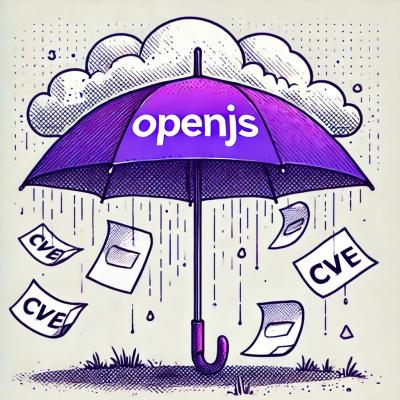
Research
Security News
Malicious npm Package Wipes Codebases with Remote Trigger
A malicious npm typosquat uses remote commands to silently delete entire project directories after a single mistyped install.
Organize your application's steps with stairs.
Here we are building an extraction process to extract data from some API.
var stairs = require('stairs');
var extractData = stairs('extract data')
.step('query api', function ($, next) {
http.get($.url, function (res) {
$.body = '';
res.on('data', function (chunk) { $.body = $.body + chunk; });
res.on('end', next);
res.on('error', next);
});
})
.step('parse json', function ($) {
try { $.data = JSON.parse($.body); }
catch(e) { return next(e) };
finally { this.skip('skip to') }
})
.step('skip to', function ($, next) {
this.next();
})
.step('grab element', function ($, next) {
$.extracted = $.data.some.field;
this.end();
})
.on('step', function (title, index, count) {
console.log('on step "%s" which is %s/%s of process "%s"', title, index, count, this.title);
});
.on('error', function (err, $) {
console.error(err);
})
.on('done', function (err, $) {
console.log('extracted %j', $.extracted);
});
Next we apply our process to a list of urls.
var urls = [
'http://some.api?id=1'
'http://some.api?id=2'
'http://some.api?id=2'
].forEach(function (url) {
extractData({url: url});
});
var stairs = require('stairs');
Creates a new instance.
var s = stairs();
Creats a new instance with a title.
var s = stairs('extraction process');
Executes the steps in the order in which they were added.
s();
Executes the steps in the order in which they were added, and when done
invokes the callback cb.
s(function ($) {
console.log($);
});
Executes the steps in the order in which they were added given a scope and when done
invokes the callback cb.
s({}, function ($) {
console.log($);
});
Executes the steps in the order in which they were added given a scope.
s.run({});
Executes the steps in the order in which they were added, and when done
invokes the callback cb.
s.run(function (err, $) {
console.log($);
});
Executes the steps in the order in which they were added given a scope and when done
invokes the callback cb.
s.run({}, function (err, $) {
console.log($);
});
Adds a step. The step function fn when invoked will get all
the parameters in the scope. For most application you may only use
one. The last argument will be the next function that will invoke the
next step. You may pass an Error object when calling next in order to
stop the flow of execution and handle the error.
s.step('query api', function ($, next) {
http.get($.url, function (res) {
$.body = '';
res.on('data', function (chunk) { $.body = $.body + chunk; });
res.on('end', next);
res.on('error', next);
});
});
Conditionally adds a step.
s.step('query api', options.skipQuery, function ($, next) {
http.get($.url, function (res) {
$.body = '';
res.on('data', function (chunk) { $.body = $.body + chunk; });
res.on('end', next);
res.on('error', next);
});
});
The "query api" step will not be added if options.skipQuery is true.
You can skip to a particular step given the title of that step by calling this.skip('skip to').
s.step('parse json', function ($, next) {
try { $.data = JSON.parse($.body); }
catch(e) { return next(e) };
finally { this.skip('skip to') }
});
You can invoke next from the callback parameter next or this.next().
s.step('skip to', function ($, next) {
this.next();
});
You can end the process by calling this.end() in your handler.
s.step('grab element', function ($, next) {
console.log('the data %j', $.data);
$.extracted = $.data.some.field;
this.end();
});
The step event is triggered for each step when being executed.
s.on('step', function (title, i, count) {
console.log('we are processing step "%s" which is step %s of %s', title, i, count);
});
The done event is triggered when the process is complete.
s.on('done', function ($) {
console.log('done.');
});
The error event is triggered whenever we receive an error.
s.on('error', function (err, $) {
console.error(err);
});
Install node.js (See download and install instructions here: http://nodejs.org/).
Clone this repository
> git clone git@github.com:turbonetix/stairs.git
cd into the directory and install the dependencies
> cd stairs
> npm install && npm shrinkwrap --dev
Install coffee-script
> npm install coffee-script -g
Tests are run using grunt. You must first globally install the grunt-cli with npm.
> sudo npm install -g grunt-cli
To run the tests, just run grunt
> grunt spec
FAQs
Organize your application's steps into stairs.
The npm package stairs receives a total of 0 weekly downloads. As such, stairs popularity was classified as not popular.
We found that stairs demonstrated a not healthy version release cadence and project activity because the last version was released a year ago. It has 3 open source maintainers collaborating on the project.
Did you know?

Socket for GitHub automatically highlights issues in each pull request and monitors the health of all your open source dependencies. Discover the contents of your packages and block harmful activity before you install or update your dependencies.

Research
Security News
A malicious npm typosquat uses remote commands to silently delete entire project directories after a single mistyped install.

Research
Security News
Malicious PyPI package semantic-types steals Solana private keys via transitive dependency installs using monkey patching and blockchain exfiltration.

Security News
New CNA status enables OpenJS Foundation to assign CVEs for security vulnerabilities in projects like ESLint, Fastify, Electron, and others, while leaving disclosure responsibility with individual maintainers.